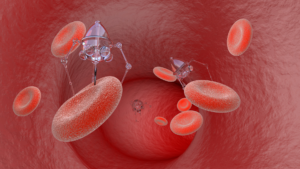
Nanorobotics refers to highly engineered, nanoscale or microscopic machines that are designed to perform complex tasks through molecular scale manipulations and functions. Nanorobots would operate at the molecular level in order to help study, design, construct and control materials, devices and molecular-sized machines. They would potentially be able to perform functions inside the human body at the cellular and molecular levels for applications in medicine, diagnostics, and disease treatment.
In medicine, nanorobots could be used for a variety of applications to enhance human health and quality of life. Some potential uses of medical nanorobots include:
-Targeted drug delivery: Nanorobots could transport drugs directly to specific cells and tissues in the body to release their payload exactly where needed. This could maximize drug efficacy while minimizing side effects by reducing systemic drug exposure in healthy tissues.
-Nanosurgery: Surgeons could potentially perform procedures with nanorobots at the cellular and molecular levels. Nanorobots could be used in applications like repairing cellular damage due to disease or injury with higher precision than traditional surgery. They may even be able to perform surgery from within the body without making external incisions.
-Remote diagnosis and monitoring: Nanorobots equipped with sensors could gather biological data from inside the body and transmit it remotely for medical analysis. They could monitor health metrics to detect early signs of disease and alert physicians before full-blown symptoms develop. Nanorobots may even be programmed to diagnose certain medical conditions autonomously through artificial intelligence inside the body.
-Tissue engineering and regeneration: Medical nanorobots could potentially help repair or replace damaged tissues and cells by transporting regenerative cells, biomaterials and drug therapies directly to areas of injury or disease in the body. They may be used to dissolve blood clots, break up arterial plaques or promote the growth of new healthy tissues.
Designing Medical Nanorobots
While the exciting potential medical uses of nanorobots seem like science fiction, significant scientific hurdles remain before such machines can become a clinical reality. Designing these miniature robots to be biocompatible and selectively interact with cells and molecules inside the human body poses major engineering challenges. Some important considerations in designing nanorobots for medical applications include:
-Materials selection: Nanorobots must be constructed with non-toxic, stable materials like biocompatible polymers or ceramics that do not induce an immune reaction or cause harm when interacting with living tissues. Materials would need to resist corrosion or degradation inside fluids and environments within the body.
-Electronics/power source: Sensors, processors and other electronic components of nanorobots require exceedingly small batteries or alternative power strategies like motion power, thermal energy, biochemical energy harnessing or inductive coupling from external sources to work autonomously for useful time periods.
-Onboard intelligence/controllers: Programmable control units using embedded computing and sensing allow nanorobots to make autonomous decisions, coordinate with other nanorobots and respond to dynamic conditions inside the body. Nanoscale equivalents of processors, memory and software still require substantial development.
-Mobility mechanisms: Locomotion schemes using artificial muscles, cilia, microjets or flagella are being explored to enable purposeful mobility of nanorobots within tissues and fluids. Movement control and navigation strategies need to be developed at such a small scale.
-Targeting capabilities: Precise mechanisms to selectively target specific cells, molecules or areas in the body are required for applications like targeted drug delivery. Targeting may involve recognizing molecular biomarkers on diseased cells using aptamers, antibodies or biomolecular sensors on the nanorobot surface.
Overcoming Challenges in Medical Nanorobotics
While medical nanorobots could revolutionize healthcare, progress in realizing this technology still requires overcoming significant scientific, engineering and technical challenges. Key challenges in developing functional nanorobotics systems for medicine include:
-miniaturization of electronic components and computational capabilities down to the nanoscale while retaining functionality. Components like sensors, processors, power sources and effectors would need to be thousands of times smaller than current microscale technologies.
-precise fabrication and assembly of nanoscale components and machines and the ability to manufacture nanorobots economically in large quantities. Current top-down nanofabrication techniques are still limited and expensive.
-navigating and controlling nanorobotic devices at such small scales within complex biological environments and physiologic conditions in the body. Interactions at the nanoscale are subject to stochastic behaviors and effects that are difficult to model.
-ensuring biocompatibility and biostability of materials, without inducing immune reactions, coagulation or toxic effects during contact with living tissues over time. Testing new nanomaterials for safety is challenging.
– programming autonomous behaviors and decision making for medical tasks without continuous external control. Developing artificial intelligence at the nanoscale also presents difficulties.
While still in early stages of research, ongoing progress in nanotechnology, materials science, engineering, computing, molecular modeling and biomedical applications could gradually help address these challenges over the next decade or more. With further advances, medical nanorobotics ultimately holds enormous promise to transform healthcare through molecular machine therapeutics.
*Note:
1. Source: Coherent Market Insights, Public sources, Desk research
2. We have leveraged AI tools to mine information and compile it



